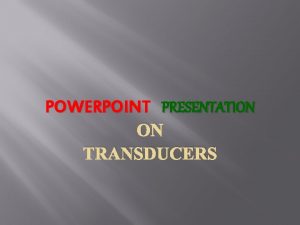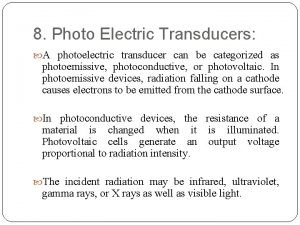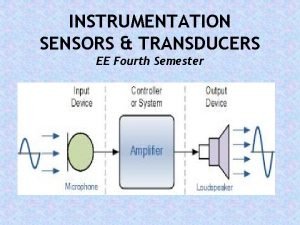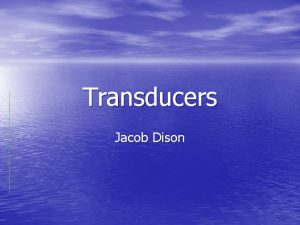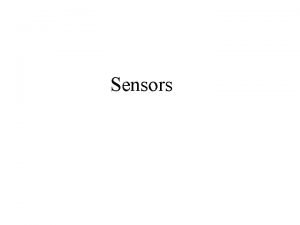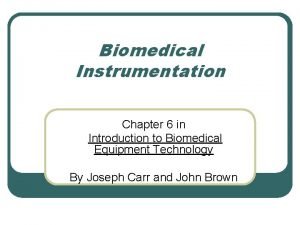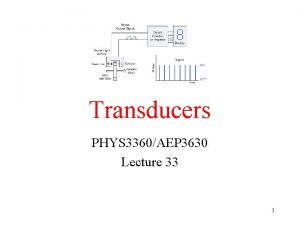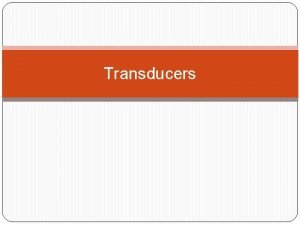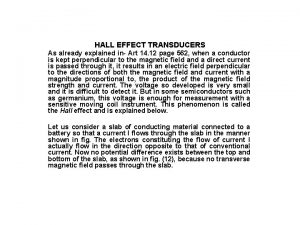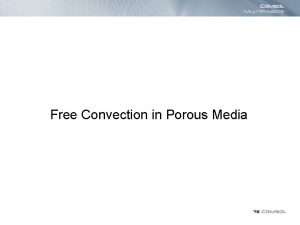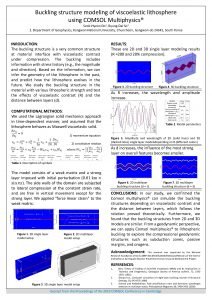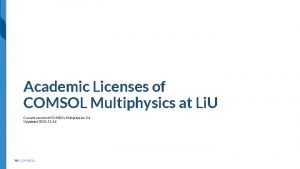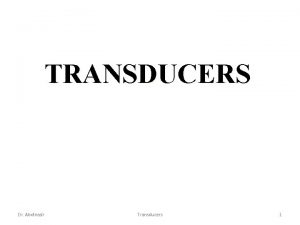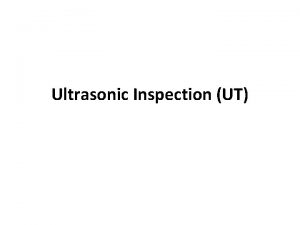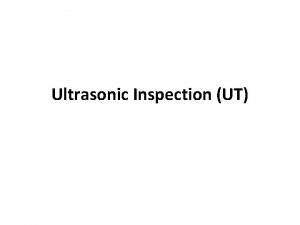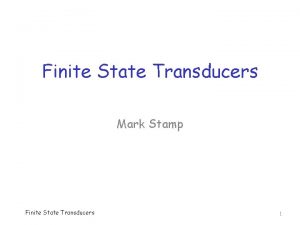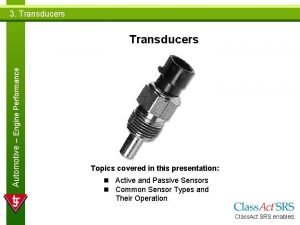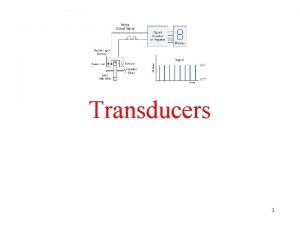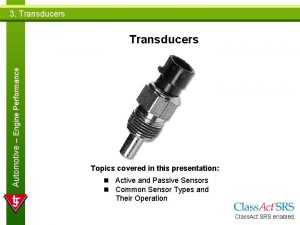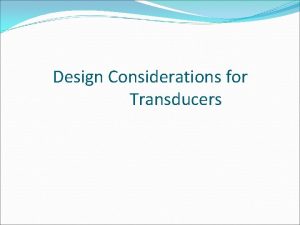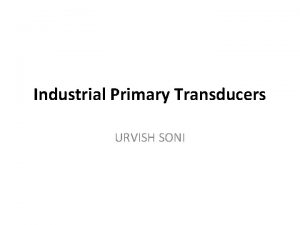Modelling of OpenType Flexural Ultrasonic Transducers Comsol Conference














- Slides: 14

Modelling of Open-Type Flexural Ultrasonic Transducers Comsol Conference September 24 th - 26 th 2019 Cambridge Author: Sam Jackson

Introduction What is an Open-Type Flexural Ultrasonic Transducers? Cross-section from Murata

Introduction Scope of this work • Measure response characteristics of a single transducer type (electromechanical and acoustic). • Model transducer operation using Comsol Multiphysics • Use simulation and experiment to gain a deeper understanding of the operation of open-type flexural ultrasonic transducers.

System Breakdown Assumptions Made • • • Components perfectly bonded and separable. Disk material: Brass, Horn material: Aluminium. Piezo material: PZT-5 A (best fit to data). Dimensions measured with a micrometer and a 3 -axis vision machine. Profile of horn approximated as line of best fit through measured points.

Model Setup • Multiphysics modelling combining piezo, mechanical and acoustic domains. • Steady state response at discrete frequencies. • Mechanical damping term added to piezo element to best fit rated Qfactor. • Rayleigh damping added to horn to represent losses due to bending. • Disk bender undamped.

System Response What is measured • Electromechanical (impedance), mechanical (component velocity, and acoustic response). • Model Shapes • Three excitation voltages, 1 Vrms (linear regime), 10 Vrms (rated operation) and 20 Vrms (high power operation). How it was measured • • Sweep response between 30 k. Hz and 60 k. Hz. Voltage probe and current clamp to obtain impedance curve. Polytec PSV-400 laser vibrometer to measure velocity. GRAS 46 BE free field microphone to measure acoustic response.

System Response - Impedance – gives an insight into the response and operation of the piezo Simulated (dashed line) and experimentally measured (solid line) electrical impedance of the transducer disk an piezo. Excitation applitude of 1 Vrms (Blue), 10 Vrms (Red) and 20 Vrms (Yellow). Simulated (dashed line) and experimentally measured (solid line) electrical impedance of the full transducer. Excitation applitude of 1 Vrms (Blue), 10 Vrms (Red) and 20 Vrms (Yellow).

System Response – Mechanical • Single disk/piezo mode, two transducer modes. • Two coupled single DOF systems. • Combination of symmetric and asymmetric modes

System Response – Mechanical 33 k. Hz Estimated Horn Shape 28 k. Hz Horn Mode (3, 1) 40 k. Hz Horn Mode (0, 1) Out of Phase 51 k. Hz 49 k. Hz Horn Mode (3, 1) In Phase 55 k. Hz 47 k. Hz Horn Mode (4, 1)

System Response – Mechanical 33 k. Hz Scanned Horn Shape 32 k. Hz Horn Mode (3, 1) 40 k. Hz 38 k. Hz Horn Mode (0, 1) Out of Phase 51 k. Hz 48 k. Hz Horn Mode (3, 1) In Phase 55 k. Hz 54 k. Hz Horn Mode (4, 1)

System Response – Mechanical Simulated (dashed line) and experimentally measured (solid line) frequency response (top) and phase (bottom) of the full tranducer at the horn center (blue), horn edge (red) and disk edge (yellow). Excitation amplitude of 1 Vrms. Measured velocity response amplitude (top) and relative phase (bottom) across the diameter of the horn at the first (blue) and second (red) resonant modes.

System Response - Acoustic Response – What the transducer actually generates Simulated (dashed line) and experimentally measured (solid line) acoustic response of the transducer at a distance of 50 mm. Excitation applitude of 1 Vrms (Blue), 10 Vrms (Red) and 20 Vrms (Yellow). Normalised simulated (dashed line) and experimentally measured (solid line) acoustic response of the transducer at a distance of 50 mm. Excitation applitude of 1 Vrms (Blue), 10 Vrms (Red) and 20 Vrms (Yellow). Note that simulated impedance curves for different voltage levels are indistinguishable.

Conclusion Key Outcomes • Strongly coupled 2 DOF system (disk/piezo and horn) • Nonlinearity and drop in Q-factor driven by piezo. • Horn acts as a mechanical amplifier, adds damping to the system. • Two symmetric transducer modes, second mechanically dominant, first acoustically dominant. • Mis-alignment between piezo resonance (minimum impedance) and system mechanical resonance causes significant drop in acoustic efficiency and Qfactor.

Questions Thank You Any Questions?
 Transducers ppt
Transducers ppt Photo electric transducers
Photo electric transducers Inductive transducers
Inductive transducers Transducers and sensors
Transducers and sensors Bidirectional transducers in automata theory
Bidirectional transducers in automata theory Advantages of lvdt
Advantages of lvdt Types of electrodes in biomedical instrumentation
Types of electrodes in biomedical instrumentation Transducer
Transducer Mechanical transducer
Mechanical transducer Hall effect transducers
Hall effect transducers Free and porous media flow comsol
Free and porous media flow comsol Comsol viscoelastic
Comsol viscoelastic Comsol induction heating
Comsol induction heating Comsol api
Comsol api Comsol fnl
Comsol fnl
